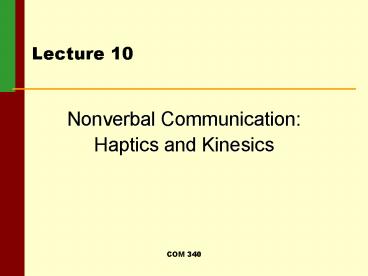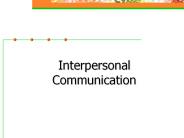Nonverbal Communication: - PowerPoint PPT Presentation
1 / 21
Title:
Nonverbal Communication:
Description:
COM 340. Lecture 10. Nonverbal Communication: Haptics and Kinesics. COM 340. 2. The average person relies heavily on touch ... Overview of Kinesics. COM 340. 18 ... – PowerPoint PPT presentation
Number of Views:368
Avg rating:3.0/5.0
Title: Nonverbal Communication:
1
Lecture 10
- Nonverbal Communication
- Haptics and Kinesics
2
Overview of Haptics
- The average person relies heavily on touch to
communicate. - Probably the most basic or primitive form of
communication. - Touch remains a crucial aspect of human relations
throughout our lives.
3
Babies and Touch
- The earliest form of contact that humans have
with the world is through touch. - Babies communicate through touch long before they
can talk. - Babies main source of information and also main
way of expression. - Doctors hands Bathing
- Diaper changing Rocking
- Feeding Comforting
4
Babies and Touch (cont)
- Studies in infant behavior have shown importance
of touch in the evolution of a healthy adult. - Infants which have been held, touched and cuddled
show - greater gain in weight,
- a higher level of activity,
- greater curiosity and capacity for learning,
- are less sick and handle stress better, and
- live longer.
5
Functions of Touch
- Among adults a vast range of meaning can be
expressed just by touching. - Classifying touch into categories
- Functional/Professional
- Social/Polite
- Friendship/Warmth
- Love/Intimacy
6
Functions of Touch (cont)
- Functional/Professional - Most impersonal type of
touch done as part of job, service or task. - Physician, Dentist, Nurse
- Barber Hairstylist
- Masseur
- Tailor
- Social/Polite - Affirms the presence of another
person suggests bond between two. - Handshake, High five
- Cheek kiss
7
Functions of Touch (cont)
- Friendship/Warmth - Friendly touch for people we
respect and hold in esteem to show fondness. - Pat on the back
- Embrace, hug
- Love/Intimacy - Reserved for individuals we care
deeply about. - Full embrace
- Stroke of the face
- Kiss
- Sexual intercourse
8
Patterns of Physical Contact
- Study conducted by Prof. Dean Barnland
- Compared physical contact patterns (touching
patterns) of Japanese and American college
students. - Study Group
- College students between 18 and 24
- 120 Japanese and 120 Americans
- Each group had 60 males and 60 females
9
Touching study results (cont)
- The drawings show a large contrast between
touching patterns in the two cultures. - Interesting to see that permitted touching is
greater with the American Father (least amount
for Americans) than it is for the Opposite
Japanese Sex Friend (most amount for Japanese).
10
Results of Study - U.S.
11
Results of Study - Japan
12
Physical Contact
- What is touched?
- Almost total agreement between both cultures on
areas of the body that can be touched and those
that should not be touched. - Among Japanese the most frequently reported areas
of contact were - Hand Forehead Head
- Shoulder Back of the neck Forearm
- Among Americans the results were the same plus
the addition of the upper arm.
13
Physical Contact (cont)
- What cant be touched?
- The areas which cant be touched were also
similar for Japanese and Americans. - For both culture following were rarely touched.
- front pelvic region rear thigh
- rear pelvic region rear lower leg
- Although some areas of physical avoidance may
reflect inconvenience rather than inhibition.
14
Physical Contact (cont)
- Who is touched?
- When total physical contact is considered,
Japanese and Americans showed their highest
frequency of touching behavior to be with friends
rather than with parents. - Japanese showed their order of physical contact
(most to least) with - 1) opposite sex friends
- 2) mothers and same sex friends (same)
- 3) fathers.
15
Physical Contact (cont)
- Who is touched?
- Americans showed similar results.
- Order of physical contact (most to least)
- 1) opposite sex friends
- 2) mothers
- 3) same sex friends
- 4) fathers.
- But opposite sex friends scored much higher with
Americans than Japanese, and fathers ranked very
close to same sex friends.
16
Physical Contact - Conclusion
- There can be major differences between cultures
in what areas of the body physical contact is
permitted and not permitted. - Each of us knows what is permitted in our own
culture, as we learn it from our parents and from
society. - However, we do not intuitively know what is
permitted in other cultures. - Making a mistake may cause an insult or make that
person angry or uncomfortable.
17
Overview of Kinesics
- Body movements transmit a variety of messages.
- Emotions
- Personality traits
- Attitudes
- Some are explicit others are less clear.
- Different movements can be used to convey the
same message. - The same movements can carry different messages.
18
Classes of Movement
- A system has been devised to classify body
movements into five groups. - Emblems
- Illustrators
- Affect displays
- Regulators
- Adaptors
19
Classes of Movement (cont)
- Emblems - movements that bring words and phrases
to the observers mind and are directly
translatable into specific words. - Good luck I dont know.
- Its hot. money
- Illustrators - movements that are linked directly
to a verbal message that clarify or explain what
is said. They - accent or emphasize a word or phrase,
- point to objects, and
- picture spatial relationships.
20
Classes of Movement (cont)
- Affect displays - movements that reflect the
intensity of our emotions or feelings. - Intense facial expressions Kissing
- Stomping feet Handshake
- Regulators - movements that control the
back-and-forth nature of speaking. - Head nods Eye movements
- Posture shift Hand gestures
21
Classes of Movement (cont)
- Adaptors - movements that are unintentional body
movements in reaction to boredom or stress. - Holding Scratching
- Rubbing Picking
- Squeezing Pinching
- Pen twirling
- Playing with an object
- Playing with ones hair or clothing
- Making restless movements with hands or feet































